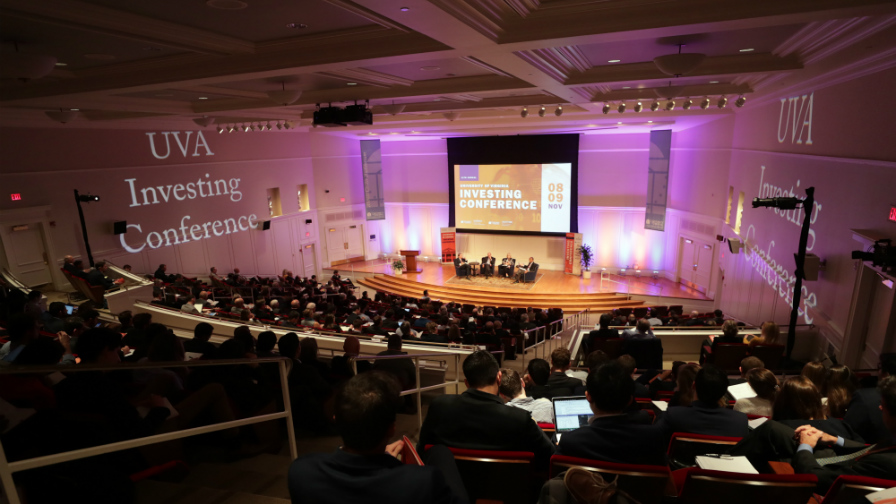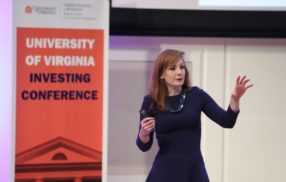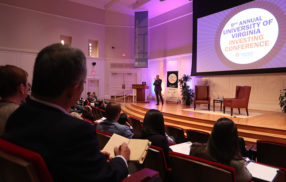
‘Crises Will Occur Again:’ UVA Investing Conference Weighs Response to Financial Crisis and Considers the Road Ahead
By Dave Hendrick
With the memory of the financial crisis of 2008 fading from popular consciousness but many of the wounds inflicted on the global economy still evident, the recent University of Virginia Investing Conference brought together many of the primary figures from the crisis to dissect what happened and whether the financial system is better prepared to withstand a future meltdown.
As UVA Darden School of Business Professor and Dean Emeritus Bob Bruner said, the conference concerned itself with three critical questions:
- What have we learned from the crisis in the 10 years since?
- What have we fixed?
- What remains to be done?
“There are lots of good reason to dwell on what we can learn from the crisis, because crises will occur again,” Bruner said, suggesting that while crises can be mitigated or guarded against, they cannot be prevented.
Bruner kicked off the conference, which was hosted at Darden and sponsored by Darden’s Richard A. Mayo Center for Asset Management and the UVA McIntire School’s Center for Investors & Financial Markets, with an oral history of the crisis featuring former Fannie Mae Chair and CEO Franklin Raines, former Citigroup CFO and Vice Chair Ned Kelly and former AIG Chief Compliance Officer Stasia Kelly, each of whom found themselves on the frontlines of the response to the crisis.
Raines, who introduced himself as “one of the 25 people to blame for the financial crisis,” as designated by Time magazine, defended his time at the government-backed mortgage broker he left in 2004, noting that he left behind a “book of business” that was profitable throughout the crisis.
Still, Raines said Fannie Mae and Freddie Mac made “huge mistakes” by pursuing the private mortgage-backed securities market, which he described as involving “institutions outsourcing their judgment to others.”
Raines laid much of the blame for the housing crisis on the efforts by Fannie and Freddie competitors that argued for a lower threshold for capital requirements for mortgages. As the housing crisis fallout unfolded, he said the government erred in not facilitating the bankruptcy of Lehman Brothers, helping to cause a cascade of unraveling, including a government takeover of Fannie and Freddie.
As to where the next crisis may be lurking, Raines suggested looking at “some asset that’s wildly popular, that’s growing rapidly and has large margins,” and mused that the fintech credit markets were worth watching closely
Former AIG executive Stasia Kelly took a position at AIG in 2006, pursuing what seemed like a “great opportunity to build a regulatory and compliance organization” within the global insurance giant, but instead turned into a key role in one of the most complex corporate bailouts in U.S. history.
Even before the crisis hit, Kelly said it was clear she had joined an organization where compliance was “something to be tolerated” and rules were loosely enforced. When the crisis hit, AIG, like scores of other large companies, found themselves unsure of how to react to a crisis without precedent. It was a failure of foresight, Kelly suggested, and one made possible by a failure to prioritize ethical actions.
“Organizations need a commitment to do the right thing from the top,” Kelly said. “When a CEO articulates his belief that people need to behave a certain way and in accordance with the rule of law, that goes all the way down through the organization. When a CEO only pays lip service, that also goes all the way through the organization.”
Kelly said other lessons from the crisis included the need for effective crisis management plans for companies large and small and enhanced early warning systems for events that may snowball into a crisis.
Despite the turmoil involved in the response to the crisis — AIG would eventually require a bailout of more than $180 billion — Kelly said she loved her role helping to save the organization.
“One of the reasons I loved what I did is because, in a crisis, there is one person people look to, and that’s the lawyers,” Kelly said.
Just as Stasia Kelly joined AIG shortly before the financial system began to buckle, Ned Kelly joined Citigroup in February 2008 and soon found himself helping steer the company through collapse and bailout.
“When you think about how quickly this crisis cascaded … September of 2008 was genuinely extraordinary,” Kelly said. “Week by week, there was a firm failing.”
Kelly said he believed federal regulators did “a fabulous job under extraordinary circumstances” of fundamentally saving the financial system, but as the popular consensus to come out of the crisis involved the notion that “banks recovered and people suffered,” players did a poor job explaining the crisis and its response.
While some memories of the financial crisis may be fading, Raines said the sense that corporations were prioritized over people remained.
“We are seeing a lot of that resentment now,” Raines said. “Too little was done to preserve people in their homes and their assets and they are mad about it and should be mad about it.”
The State of Banking Today
The oral history panel was followed by a group with a current banking focus, including outgoing Citigroup Chairman Michael O’Neill (MBA ‘74) and his incoming successor, John Dugan, who served as comptroller of the currency in the U.S. Department of the Treasury from 2005–10.
Dugan said the banking system was significantly stronger than in the years leading up the crisis, noting increased capital requirements, various changes to governance and the so-called “living wills” intended to provide for an orderly liquidation in a future bankruptcy event.
Said Dugan, “People can take issue as to whether what banks have done is too little, but changes have been really substantial to make them safer.”
O’Neill offered a granular dive into the before and after at Citibank, comparing various key metrics in 2007 versus the third quarter of 2018.
O’Neill, who became chairman of Citibank in 2012, said the company had $827 billion in “troubled” assets in 2007, and over time the assets have been replaced with what he described as a “comparable number of untroubled assets.”
In addition to shedding the remaining troubled assets in a commercially viable manner, O’Neill described his imperatives as leader of the board as centralizing and strengthening risk management and recruiting board members who were true subject matter experts in areas of the bank’s business.
Reflecting on the Government Response
Other key players in the crisis response presenting at the conference included Jim Millstein, who left his position as global co-head of corporate restructuring at Lazard to take the role as the chief restructuring officer in the U.S. Treasury Department from 2009–11, and Sheila Bair, chair of the Federal Deposit Insurance Corp. from 2006–11.
Millstein said he was drawn into the fray on the day after the election of President Barack Obama when a friend in the new administration called and asked if he could assist with what had become a restructuring problem of epic proportion.
“I thought it would be unlikely in my lifetime that my particular expertise would be required by the federal government, but here it was,” said Millstein.
Millstein recounted the efforts to use the $750 billion in funding from the Troubled Asset Relief Program to buy up equity in financial institutions, as well as the three separate restructurings undertaken to keep AIG debt investment grade — as the loss of the status would have ended the company’s ability to write insurance policies.
The federal government eventually recouped all of the money it put into the response efforts, Millstein reminded the audience.
“It was a profitable exercise, but more importantly it was an effective exercise,” Millstein said.
Similarly, Bair said she “gets nervous” when she hears people talk about “bailout rules,” hoping there is never cause to put them to use.
Although Bair said she was proud of the work accomplished by the FDIC — noting that no consumers lost any insured deposits — she remains generally critical of certain aspects of the bailout, notably what she described as the missed opportunity to “impose accountability when we had the opportunity.”
“We basically have the same system we had prior to the crisis,” Bair said. “It’s safer and better capitalized and there are better parameters around risk taking. There have been a lot of improvements, but it is still basically the same system. Is that going to be enough? I hope so.”
Watch additional video insights from the University of Virginia Investing Conference.
The University of Virginia Darden School of Business prepares responsible global leaders through unparalleled transformational learning experiences. Darden’s graduate degree programs (MBA, MSBA and Ph.D.) and Executive Education & Lifelong Learning programs offered by the Darden School Foundation set the stage for a lifetime of career advancement and impact. Darden’s top-ranked faculty, renowned for teaching excellence, inspires and shapes modern business leadership worldwide through research, thought leadership and business publishing. Darden has Grounds in Charlottesville, Virginia, and the Washington, D.C., area and a global community that includes 18,000 alumni in 90 countries. Darden was established in 1955 at the University of Virginia, a top public university founded by Thomas Jefferson in 1819 in Charlottesville, Virginia.
Press Contact
Molly Mitchell
Associate Director of Content Marketing and Social Media
Darden School of Business
University of Virginia
MitchellM@darden.virginia.edu








